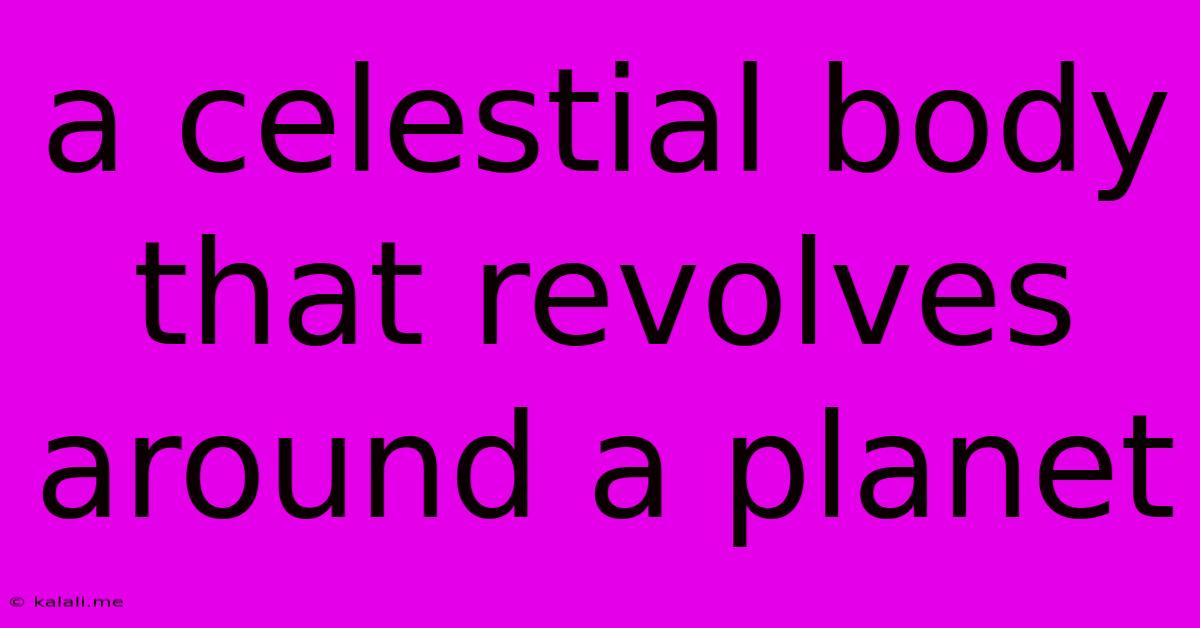A Celestial Body That Revolves Around A Planet
Kalali
Jun 15, 2025 · 3 min read

Table of Contents
Unveiling the Mysteries of Moons: Celestial Bodies Orbiting Planets
Moons. These fascinating celestial bodies, often overlooked in the grandeur of planets and stars, are captivating worlds in their own right. They're a fundamental part of our solar system and beyond, offering a window into the formation and evolution of planetary systems. This article delves into the fascinating world of moons, exploring their origins, characteristics, and the crucial role they play in the dynamics of their parent planets.
A moon, or natural satellite, is a celestial body that orbits a planet or other smaller body, such as a dwarf planet or even a large asteroid. Unlike planets, which orbit stars, moons are bound gravitationally to their primary body. The sheer diversity of moons in our solar system alone underscores the complex processes that govern their formation.
The Formation of Moons: A Multifaceted Process
The origins of moons are a subject of ongoing scientific investigation, but several key formation mechanisms are generally accepted:
-
Capture: Some moons may have formed independently and were later captured by a planet's gravitational pull. This process often involves a significant amount of energy dissipation, usually through interactions with other celestial bodies.
-
Co-formation: Many moons are believed to have formed concurrently with their parent planet from the same protoplanetary disk. This process is particularly relevant to larger moons, such as our own Moon, which share compositional similarities with their parent planet.
-
Collisional Formation: The giant-impact hypothesis, for example, posits that our Moon formed from debris ejected after a Mars-sized body collided with early Earth. This theory explains several key features of the Earth-Moon system.
-
Secondary Capture: Some smaller moons are thought to have formed through a secondary process where smaller bodies within a system accrete into a larger moon.
The Diversity of Moons: From Icy Worlds to Volcanic Havens
Moons exhibit remarkable diversity in size, composition, and geological activity. Some key examples include:
-
Ganymede (Jupiter): The largest moon in our solar system, Ganymede boasts a subsurface ocean and a complex magnetic field.
-
Titan (Saturn): Known for its dense atmosphere and liquid methane lakes, Titan offers a unique environment for studying prebiotic chemistry.
-
Europa (Jupiter): Covered in a thick ice shell, Europa is believed to harbor a vast subsurface ocean potentially containing more water than all of Earth's oceans combined. This makes it a prime target in the search for extraterrestrial life.
-
Enceladus (Saturn): This small moon exhibits cryovolcanism, erupting water vapor and ice particles from its south polar region, suggesting hydrothermal activity within its icy shell.
The Influence of Moons on Their Planets
Moons aren't simply passive companions; they play a significant role in the dynamics of their planetary systems:
-
Tidal Forces: The gravitational interaction between a planet and its moon creates tidal forces, which can cause tides in oceans and even influence the planet's rotation.
-
Orbital Stability: The presence of moons can stabilize a planet's orbit and even influence the formation of planetary rings.
-
Atmospheric Influences: The gravitational pull of a moon can affect a planet's atmosphere, contributing to its composition and dynamics.
Ongoing Research and Future Discoveries
The study of moons continues to advance, with ongoing missions like the Europa Clipper and future explorations planned. These missions will provide crucial data to better understand the formation, evolution, and potential habitability of these fascinating celestial bodies. The search for exomoons, moons orbiting planets outside our solar system, is also a burgeoning field of research, promising to further expand our understanding of planetary systems and the prevalence of moons in the universe. The secrets held within these distant worlds remain largely unknown, making the study of moons one of the most exciting and promising areas of modern astronomy.
Latest Posts
Latest Posts
-
How Many Legs Do Ant Have
Jun 15, 2025
-
Which Of The Following Is True Of Human Development
Jun 15, 2025
-
Which Of The Following Differentiates Between Formal And Informal Groups
Jun 15, 2025
-
Kabir Das Dohe In Hindi With Meaning
Jun 15, 2025
-
A Generator Is A Device That Converts
Jun 15, 2025
Related Post
Thank you for visiting our website which covers about A Celestial Body That Revolves Around A Planet . We hope the information provided has been useful to you. Feel free to contact us if you have any questions or need further assistance. See you next time and don't miss to bookmark.